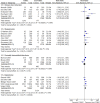Effects of female genital cutting on physical health outcomes: a systematic review and meta-analysis
- PMID: 25416059
- PMCID: PMC4244458
- DOI: 10.1136/bmjopen-2014-006316
Effects of female genital cutting on physical health outcomes: a systematic review and meta-analysis
Abstract
Objective: Worldwide, an estimated 125 million girls and women live with female genital mutilation/cutting (FGM/C). We aimed to systematically review the evidence for physical health risks associated with FGM/C.
Design: We searched 15 databases to identify studies (up to January 2012). Selection criteria were empirical studies reporting physical health outcomes from FGM/C, affecting females with any type of FGM/C, irrespective of ethnicity, nationality and age. Two review authors independently screened titles and abstracts, applied eligibility criteria, assessed methodological study quality and extracted full-text data. To derive overall risk estimates, we combined data from included studies using the Mantel-Haenszel method for unadjusted dichotomous data and the generic inverse-variance method for adjusted data. Outcomes that were sufficiently similar across studies and reasonably resistant to biases were aggregated in meta-analyses. We applied the instrument Grading of Recommendations Assessment, Development and Evaluation to assess the extent to which we have confidence in the effect estimates.
Results: Our search returned 5109 results, of which 185 studies (3.17 million women) satisfied the inclusion criteria. The risks of systematic and random errors were variable and we focused on key outcomes from the 57 studies with the best available evidence. The most common immediate complications were excessive bleeding, urine retention and genital tissue swelling. The most valid and statistically significant associations for the physical health sequelae of FGM/C were seen on urinary tract infections (unadjusted RR=3.01), bacterial vaginosis (adjusted OR (AOR)=1.68), dyspareunia (RR=1.53), prolonged labour (AOR=1.49), caesarean section (AOR=1.60), and difficult delivery (AOR=1.88).
Conclusions: While the precise estimation of the frequency and risk of immediate, gynaecological, sexual and obstetric complications is not possible, the results weigh against the continuation of FGM/C and support the diagnosis and management of girls and women suffering the physical risks of FGM/C.
Trial registration number: This study is registered with PROSPERO, number CRD42012003321.
Keywords: circumcision; consequences; female; female genital cutting; health; systematic review.
Published by the BMJ Publishing Group Limited. For permission to use (where not already granted under a licence) please go to http://group.bmj.com/group/rights-licensing/permissions.
Figures




References
-
- WHO. Eliminating female genital mutilation: an interagency statement. Geneva: World Health Organization, 2008.
-
- UNICEF. Female genital mutilation/cutting: a statistical overview and exploration of the dynamics of change. New York: UNICEF, 2013.
-
- Wade LD. Ideological context and the framing of female genital mutilation. Paper presented 2005–08–12 at the annual meeting of the American Sociological Association; Philadelphia, 2000. http://citation.allacademic.com/meta/p20640_index.htmlWHO (accessed 26 Jul 2013).
-
- Obermeyer CM, Reynolds RF. Female genital surgeries, reproductive health and sexuality: a review of the evidence. Reprod Health Matters 1999;7:112–20.
-
- Obermeyer CM. The consequences of female circumcision for health and sexuality: an update on the evidence. Cult Health Sex 2005;7:443–61. - PubMed
Publication types
MeSH terms
LinkOut - more resources
Full Text Sources
Other Literature Sources
Medical
